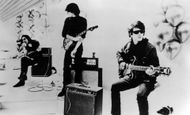Coming from the wild and loud New York City of the mid-1960s, The Velvet Underground cut its own path, different from any other band at that time. They mixed harsh words with hard, bold sounds.
The original lineup with Lou Reed's sharp words hit hard, and he spoke them with a blank face. John Cale brought a new way of sound and deep music know-how to The Velvet Underground, Sterling Morrison played the guitar well, and Angus MacLise added free and wild beat play. They showed the real, tough side of the city's hidden places and art spots.
When Moe Tucker came in for MacLise in 1965, her simple, big drum style made their music more raw and put you in a trance. With the help of the famous art star, Andy Warhol, they turned into the main show of his Exploding Plastic Inevitable events. There were quick light flashers, film projects that tried new things, and out-there shows that mixed up music and art actions.
Their first work, The Velvet Underground & Nico (1967), with the odd German singer and model Nico in a few songs, was a big shift from the late '60s peace and love vibe. It took a hard look at tough themes like addiction, city life woes, and bold sexual acts.
Though it did not sell well then, lost in all the main pop scenes and not getting right by reviewers, its clear truth and bold sounds set the stage for many new music styles, from punk and noise rock to indie and shoegaze. Looking back, its mark can't be counted; Rolling Stone once called it the "most prophetic rock album ever."
Years on, The Velvet Underground's bold style and wild tries still push new musicians and artists who find beauty in what's rough and real. Their short run from 1965 to 1973 is a top show in rock of how real new ideas often take years to be liked.
Disclaimer: This article contains the writer's opinion. Reader's discretion is advised!
Here are the top 7 The Velvet Underground songs of all time
When we talk about the best songs by The Velvet Underground, it's not about hit charts but how each song hit rock music hard. Here are seven songs of The Velvet Underground that show off their bold takes on hard topics, their wild sound mixes, and the sharp, deep words of Lou Reed.
From the raw, loud guitars to Nico's deep, cool voice and Moe Tucker's strong drumbeats, each song on this list proves why The Velvet Underground is one of the top cult bands ever. Years on, these songs still feel new, moving through punk, alt, and indie rock like a hidden guide for those who dare to walk new paths.
1) Heroin (1967)
When we talk about The Velvet Underground's mark, Heroin is seen as the true show of their bold spirit. Let's not forget that when rock songs did not often talk about addiction, this track broke all the rules: no bass to hold it down, only Lou Reed's true voice mixed with John Cale's harsh electric viola.
Add the dreamy spin of two guitars and non-stop drum beats. The song moves like a high, rising and falling, like the wild rush of heroin itself, a new sound back in the 1960s. Reed's sayings are both shockingly direct and oddly nice: "I don’t know just where I'm going, but I'm gonna try for the kingdom if I can." The repeated sound drags you into a deep state that feels both pulling and scary.
What sets Heroin apart is how it doesn't judge; it instead makes you sit in the drug user's head for seven wild minutes. Looking back, The Velvet Underground's bold new try led the way for many new and punk acts who saw strength in the true rough grace.

It's not a shock that, years on, Heroin is still seen as The Velvet Underground's deep, dark top work, a song that took hold of a time and feel that kind of rock tunes did not dare to touch. As Reed sings, "And thank God that I just don't care," you see that this was not just a song; it was a door pushed wide open.
Read More: Top 5 best Pink Floyd stage performances of all time
2) Sweet Jane (1970)
Sweet Jane is still a top hit from the Velvet Underground, a big nod to Lou Reed's mix of tough street talk and catchy music, something not often found in the band's rough set of songs. First made for the 1970s Loaded, the track was cut short by the label, taking out a key part that Reed really wanted to keep.
Luckily, newer versions brought back the lost part, letting the song shine with all its cool style and mixed feelings.
At its core, Sweet Jane is Reed's coolness and slyness: "Standing on the corner, suitcase in my hand / Jack is in his corset, and Jane is in her vest…" Those two lines have been covered and homaged more times than anyone can count, from Mott the Hoople's glam rock to Cowboy Junkies' haunting version that sounds like they're soundtracking Natural Born Killers.
The riff is unforgettable, partly because of the Sunn amp cranked up to 11. Beyond the hook, Sweet Jane is a pivot point, a bridge from the Velvet Underground's art rock to Reed's solo career, a singalong anthem that still has the avant-garde lurking behind every chord.
3) I'm Waiting For The Man (1967)
I'm Waiting for the Man shines as a raw, true look at 1960s New York's hidden life by The Velvet Underground. It turns a plain drug deal into a deep city song. Lou Reed's words take you right into the city's rough parts: "Hey white boy, what you doin' uptown? / Man, you know I'm just waitin' for the man."
With a strong piano and sharp guitar, the song feels like a wild train, showing the raw sound that made other songs like White Light/White Heat big later.
Since its first play in 1967 on The Velvet Underground & Nico, many artists have made it their own, showing how its deep, catchy beat stays fresh. This song really gets the feel of Warhol's Factory, part wild dance spot, part raw view of an age that formed art, music, and cool new ways all together.
4) White Light / White Heat (1968)
When the Velvet Underground released the song White Light/White Heat in early 1968, they made a big change from the artful style of their first album from the year before. They did not make their music softer for more people to like. Instead, they took it deeper into a wild world of loud, rough sounds and bold words.

The song starts with strong piano sounds, loud and non-stop, like a nod to the start of rock and roll. It brings back the raw feel of early rock stars such as Jerry Lee Lewis or Fats Domino. However, it's all wrapped in a thick, almost tight noise. Mixed with loud guitars and rough singing, the music pushes on like a train off its tracks, not slowing down at all.
But under the wild jam, there's a darker truth that the Velvet Underground always touched: the fast and wild ride of using meth. Reed's way of singing turns the happy beat into something dark, especially when he says, "White light, goin’ messin' up my mind / White light, and don't you know it's gonna make me go blind," lines that show both the fun and the harm of using drugs.
This mix of happy rock and dark story gives the song a power that lasts past its time; it made a model for punk's bold, rough sound and noise rock's wild tests. Even years later, White Light/White Heat is still a sign of how brave The Velvet Underground was in making music that pushed, stirred, and shook the rules of what rock could be.
5) Lisa Says (1969)
When VU came out in 1985, it opened a new view on The Velvet Underground's secret times. This album had 15 songs made from 1968 to 1969, a time when the band was moving from their loud, early chaos to a smoother, yet still very raw style. For a lot of true fans, VU was an eye-opener. It showed how the band's style was changing as they began to break apart. One key song, Lisa Says, shows how Lou Reed loved to make stories about people with a mix of soft and raw truth.
Lisa Says was a tune that walked with Reed all through his time alone on stage. He went back to it, changed it, and gave it new shapes many times, showing how he liked to mix old and new thoughts. Reed always liked songs with names like that: Stephanie Says, Caroline Says, and Candy Says. Each one takes a look at women and the tricky ties.
The song's take in the VU album shows a quiet, almost easy beauty. Yet, the most raw and full-of-heart version came out in 1969: The Velvet Underground Live. There, the song grows and fills up with the vibe of a late-night play. The soft shift in music keys and the dreamlike break in the middle seem like peeks into Reed's mixed mind.
They show the deep thinking and sexual vibes that would mark much of his work on his own later. As he sings, "Lisa says that it's alright / When she meets me alone at night," you feel the mix of desire and space, a mix that Reed would explore for years.

In many ways, VU isn't just a collection; it's a lost puzzle bit that helps show how Reed's busy mind kept changing rock's options long after The Velvet Underground had moved on.
6) Candy Says (1969)
The song Candy Says starts The Velvet Underground's third album softly, like a quiet secret shared in the dim light of a late-night room. Rather than using the harsh sounds the group is known for, Lou Reed goes for a soft feeling here. He lets Doug Yule sing the main part, while he stays quiet in the back, a move that makes the song's sad mood even stronger.
With words like "Candy says I've come to hate my body / And all that it requires in this world," Reed shows the deep pain Candy Darling feels, wanting to let go of a self that never felt right. Even though it is soft in sound, the song's gentle tune is very different from its deep, harsh look inward about who we are and feeling out of place.
These are ideas Reed would take on more directly in the rough beauty of Berlin (1973). Years later, Candy Says is still one of Reed's most moving pics of wanting; it shows that his quiet times often held deep truths.
7) Sister Ray (1968)
The Velvet Underground's Sister Ray is seen as one bold move in sound from the late 1960s, a wild storm of noise that rips the usual song shape. At an eye-catching 17 and a half minutes, this big jam filled the whole back half of their 1968 album White Light/White Heat, testing limits that even edge rock bands hardly tried.
The story is that their sound man left partway through, as he couldn't deal with the nonstop fuzz and made-up play, only to come back when the band had pulled all the sound they could from their tools. What makes Sister Ray so gripping isn't just its loud sound or long run, but its wild nature: Lou Reed's sharp guitar clashes with John Cale's loud organ sounds.
Together, The Velvet Underground make a wild but oddly drawing beat. Under all the noise, there's a tough, early punk feel and bits of free jazz trying to break out. Reed's harsh voice cuts clear through the chaos: "I'm searching for my mainline / I said I couldn't hit it sideways." Looking back, Sister Ray didn't just change the game; it built the base for punk noise, art rock, and lots of other bands who saw beauty in not fitting in.
In general, The Velvet Underground’s list of albums is still one of the most leading and most influential sets in rock history. With just a few albums, they broke the norms of what hit music could be, mixing real, ground-level tales with wild sounds, simple charm, and bold topics.
From the eerie art-pop of The Velvet Underground & Nico to the rough sound trips of White Light/White Heat and the deeper looks of their later works, they did not stick to one style for long. Even though they were not big sellers back then, the band's brave style helped make a path for punk, indie, alternative, and many types that like art over normal gloss. Years after, their music still rings as a sign that tunes can be bold, true, and ahead of their time, all together.
Keep reading SoapCentral for more informative content!
Also Read: 6 best stage performances of Madonna
